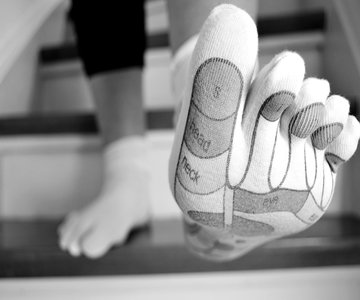Who is a Podologist? What does a foot doctor do?
Who is a podologist?
A podologist is a medical doctor who specializes in providing comprehensive leg and foot care. The study of podology covers a wide range of topics. These include the anatomy of the foot, deformities of the foot, implications of diabetes and chronic diseases on the limbs and diseases of the skin and nail. A podologist has knowledge of advanced foot pathology. He/she can help correct ingrown nails, solve lymphatic problems of the lower extremities, treat cracked heels and handle many more problems that affect the feet.
Who is a podiatrist?
A podiatrist is a doctor of podiatric medicine, physician or surgeon who specializes in diagnosing and treating the foot, ankle and lower extremities of the leg. In essence, the doctor specializes in surgical treatment of any disorder that affects the foot, ankle and lower structures of the leg.
It takes four years of study in an accredited podiatric medical school. This is followed by a four-year hospital-based residency training for an individual to qualify as a doctor of podiatric medicine. Once licensed by the relevant authorities, a podiatrist may perform reconstructive and microsurgeries, treat foot fractures, administer sedation, prescribe orthotics, casts, insoles and prosthetics and perform other tasks associated with the treatment of the foot, ankle and related leg structures.
Who is a chiropodist?
A Chiropodist is a health care professional who specializes in treating the feet. They deal with day-to-day foot problems such as ingrown nails, bunions and fungal infections among many other issues. Chiropodists work similarly to podiatrists in the sense that they perform the same tasks, including assessing, diagnosing and treating the lower limb.
They are qualified to deal with foot problems such as arthritis, nail surgery and different foot injuries and fractures. The highlight of chiropody is that the profession was somehow unregulated, in that chiropodists did not have to go through years of study as modern-day podiatrists. For this reason, the term chiropodist is no longer in use in most countries to avoid confusion and the negative perception associated with the profession.
Differences between a podologist, a podiatrist and a chiropodist
In some countries, a podologist is widely known as a podiatrist or chiropodist. However, despite the striking similarities in the profession, a podologist does not do the same job as a podiatrist or a chiropodist. Below are the differences between a podologist, a podiatrist and a chiropodist.
Based on the above information, there is no major difference between a podiatrist and a chiropodist. They both deal with foot problems, including bunions, toenail fungus, ingrown toenails, athlete’s foot and sports injuries. Nevertheless, the term chiropodist is not so common nowadays, considering the fact that the profession was somehow informal and unregulated in yesteryears. It is not until recently that chiropody has evolved and become more professional by adopting highly advanced training modules and embracing practices that are more stringent. In fact, the term chiropody is no longer in use in most developed countries except the UK.
On the other hand, a podologist is a professional who specializes in providing comprehensive leg and foot care. However, in the medical world, a podologist is not considered to operate at the same level as a podiatrist or a chiropodist. This is because podologists do not undergo the same form of diagnostic training as podiatrists. In essence, podologist have limited diagnostic skills in comparison to podiatrists.
Reasons to see a foot doctor
A foot doctor operates in the same manner as any other healthcare professional. However, in this case, they concentrate on providing comprehensive leg and foot care. You should see a podologist or a podiatrist as soon as you notice any foot problem. Some of the foot ailments that require urgent attention include:
Bunions
Bunions are bumps that appear on the side of the big toe, making it very painful to walk. The exact cause of bunions remain unknown, but various conditions such as gout, rheumatoid arthritis and wearing tight-fitting shoes may significantly increase the risk of developing bunions. Diagnosis and treatment is only undertaken by a foot specialist
Ingrown toenails
Ingrown toenails refer to a condition typified by the development of the nails into the skin rather than over it. The condition comes because of fungal attacks, poor foot structure, wearing tight shoes and improper toenail care.
Hammertoe
A hammertoe is a condition that results in the deformity of the little toes. The condition occurs because of an imbalance between the ligaments and muscles that hold the toes. A foot specialist may help in diagnosis the problem and recommending effective treatment options.
Plantar fasciitis
Plantar fasciitis is the inflammation of the fascia ligament due to over pronation of the heel or foot’s arch. Common symptoms include pain when climbing stairs, persistent pain after standing for long and stiffness in the morning.
Athlete’s foot
Athlete’s foot is a contagious fungal condition characterized by itching, stinging and burning feet and toes. The disease commonly affects athletes when sharing wet locker rooms and public showers. The condition is extremely difficult to treat and it requires professional help from a foot doctor.
Podologists and podiatrists are specialists when it comes to handling foot and ankle problems. They undergo years of training, including hospital-based surgical training to perfect their skills and knowledge. Furthermore, they have ample experience in terms of administering medications, ordering tests and establishing the right diagnosis. They are also competent as far as treating emergency foot conditions are concerned. So, in case of any foot ailment, do not hesitate to visit a professional podologist or a podiatrist.
What is a Pediatric Podiatrist?
As the name implies, a pediatric podiatrist is a foot doctor who specializes in treating foot and ankle problems in children. Apparently, many adult foot problems begin during childhood. With this in mind, a pediatric podiatrist performs the delicate act of identifying and preventing these issues early. They undergo special training for years in order to diagnose and treat pediatric foot issues at an early age.
Some of the foot problems that affect kids include:
– Flatfoot deformity
– Ingrown toenails
– Fractures
– Clubfoot
– Plantar wards
– Ligament tears
– Gait abnormalities
Take Away
If you are suffering from any foot issues, always make a point to consult a qualified podiatrist. Visiting a foot specialist is seemingly the only way to receive the correct diagnosis and treatment options.s the name implies, a pediatric podiatrist is a foot doctor who specializes in treating foot and ankle problems in children. Apparently, many adult foot problems begin during childhood. With this in mind, a pediatric podiatrist performs the delicate act of identifying and preventing these issues early. They undergo special training for years in order to diagnose and treat pediatric foot issues at an early age.




